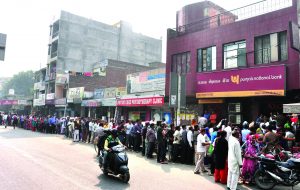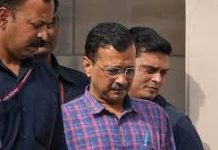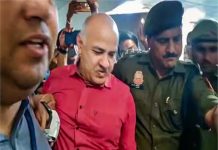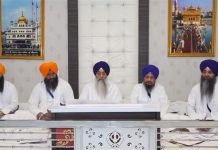 With the final outcome of the hustings for the Lok Sabha to be announced on May 23, all available indicators at this juncture point out that the Bhartiya Janata Party (BJP) is very unlikely to repeat its 2014 performance owing to its failure to deliver on its promises, especially on eradicating black money, creating 20 million jobs annually, addressing farmers’ distress, building Ram Temple etc.
With the final outcome of the hustings for the Lok Sabha to be announced on May 23, all available indicators at this juncture point out that the Bhartiya Janata Party (BJP) is very unlikely to repeat its 2014 performance owing to its failure to deliver on its promises, especially on eradicating black money, creating 20 million jobs annually, addressing farmers’ distress, building Ram Temple etc.
On the other hand, drastic measures like demonetization and improper implementation of the GST proved instrumental in adding to the people’s socio-economic woes paving way for the growing disenchantment of the masses with the Modi government and the people reflected their angst by voting against the BJP in the three major states of the Hindi Heartland – Chhattisgarh, Madhya Pradesh and Rajasthan in December 2018.
Towards decline
Ouster of the BJP-led government in three major states in the Hindi Heartland culminated in the emergence of an array of pre-poll surveys in January this year predicting inability of the BJP to garner enough numbers of its own to retain power at the Centre. Adding to the bilked BJP’s woefulness has been the flurry of hectic activity by the non-BJP political parties to foster alliances with regional satraps.
Undoubtedly, efforts for Opposition unity had started gathering momentum in the aftermath of the installation of the government in Karnataka led by an alliance of JD (S) and Congress in May 2018; nevertheless, the BJP seldom seemed to be worried about this development.
Coming together of the SP and BSP in UP and efforts undertaken by West Bengal chief minister Mamta Banerjee in bringing non-BJP political parties together and her hosting of well-attended Opposition rally in Kolkata in January this year did unnerve the BJP, though it didn’t show any sign of embarrassment. Until the closing part of the second week of February this year, most of the pre-poll surveys predicted declining curves of the BJP prospects in the ensuing general elections.
National security
However, the terrorist violence in Pulwama where over 40 CRPF jawans were martyred on February 14 and subsequent airstrike by Indian Air Force inside Pakistan at Balakot on 26 February followed by the release by Pakistan of the captured IAF pilot Abhinandan Varthaman proved instrumental in changing the national narrative from basic issues like unemployment, agrarian crisis and the alleged Rafale scam.to terrorism and national security as key issues, thereby providing the BJP an edge over its rivals in the popularity graph.
At this juncture, many critics opined that it was too simplistic to say that Pulwama and Balakot had guaranteed PM Modi a second term in office. However, in the wake of Pulwama and Balakot fading from the public memory and the persistent standoff between India and Pakistan ending in an embarrassment for India, some analysts opined that this could harm PM Modi in the upcoming elections. With the announcement of polling dates and coming into effect of the model election code, electoral campaigning has got a fillip and not-so-large public attendance in PM Modi’s rallies has been worrisome for the BJP.
The BJP’s hopes of reaping electoral dividends in the wake of nationalistic fervidness stemming from Pulwama and Balakot that had started becoming diluent received further jolt when the Congress president Rahul Gandhi promised to implement NYAY scheme. According to one critic, PM Modi perhaps understood that the Congress was beginning to seize the initiative by forcing ‘Aay Pe Charcha’ as against the Modi-Shah bouquet of pre-election jumlas.
In order to prop up people’s sagging interest in the nationalistic narrative, Modi in a tweet on March 27 announced that he would be addressing the nation with an important message which was telecast and aired after one hour of the tweet and the intervening one hour kept the people guessing the nature of announcement because Modi is known for springing surprises like demonetization.
Modi’s announcement of India’s prowess in space technology via ASAT, which would have been left to the DRDO, has been dubbed as a move by the BJP to get political mileage from this event. Some critics have pointed out that such an attempt by the BJP makes it seem as if the BJP is itself grasping at straw in the hope of finding something that could connect to the people. Another critic has opined that it can be evidenced from the tone and tenor of Modi presenting the accomplishment that he is worried about the feedback he is receiving from the mood of the electorate.
Dim prospects
Overall prospects for the BJP repeating its performance of 2014 seem dim. Salience of perennial issues of jobs for the youth, agrarian distress and party’s failure in delivering on its promises over the ephemeral nationalistic fervidness and growing surge of the Congress and emerging alliances of regional satraps are likely to dent BJP’s electoral grip. This is also attested to by the recently conducted pre-poll surveys.
The BJP’s prospects in the ensuing Lok Sabha polls are critically linked to repeating its sweep in the Hindi Heartland. In the aftermath of having lost Chhattisgarh, Madhya Pradesh and Rajasthan, the BJP will find it cumbersome to repeat its 2014 performance of winning 62 out of 65 seats. In Madhya Pradesh where the BJP won 27 out of 29 seats in 2014, is likely to incur heavy losses as predicted by Poll Eyes.
In Jharkhand, where the NDA won 12 out of 14 seats in 2014, the NDA is ahead in 5 seats whereas the UPA is ahead in nine seats, as per Poll Eyes survey. In Chhattisgarh, where the Congress registered a landslide victory in the assembly polls in December last year, the BJP is likely to suffer a big jolt. In Gujarat where the BJP won all 26 seats in 2014, is likely to win 16 seats as per Poll Eyes survey.
UP, Bihar, Maharashtra, Tamil Nadu and West Bengal are significant states for any party to wrest power at the Centre. In 2014, the BJP had swept polls in UP and garnered good number of seats in Bihar and in Maharashtra it contested in alliance with Shiv Sena and secured good number of seats. However, scenario in UP and Bihar has undergone a sea change presently.
Alliance between SP, BSP and RLD has unnerved the BJP and Congress is also fielding its candidates and the cumulative impact can damage the prospects of the BJP. Most of the pre-poll surveys have predicted advantage SP-BSP alliance and rule out replication of 2014 for the BJP. In Bihar, as well, the NDA is projected to yield place to UPA with the BJP cornering less than 10 seats of its own. In Maharashtra, the BJP-Shiv Sena combine is predicted to underperform as compared to 2014.
In West Bengal, the TMC is likely to call the shots with the BJP struggling to save its grace, albeit it may improve its percentage share of votes. In Odisha, the BJD is likely to hold the fort with the BJP making a gain of couple of seats. In Andhra Pradesh and Telangana, the parties already in power are likely to retain their supremacy giving no space for the BJP.
An identical picture is likely to emerge in Tamil Nadu, and Kerala. The BJP may gain a couple of seats in Tamil Nadu on account of its alliance with AIADMK and in Kerala it may secure one seat, as per average of different pre-poll surveys. In Assam and other North-Eastern states where the BJP had performed excellently in 2014 is very unlikely to replicate the same performance, especially in the wake of public angst against BJP’s move to impose Citizenship bill. Thus, the overall scenario presents a dismal prospect for the BJP in securing even a bare majority of its own in the ensuing Lok Sabha polls.
Way ahead
Undoubtedly, the final outcome will be declared on May 23; nevertheless, the emerging trends are unfavourable for the BJP to retain its hold on power at the Centre of its own. In case, the BJP is able to secure around 200 seats, then other constituents of the NDA will be in a strong position to dictate their terms to form a coalition government sans Narendra Modi. Admittedly, the BJP is likely to emerge as the single largest party and it will have to elicit the support of other regional parties to be enthroned. In case, other constituents disapprove of Modi’s leadership, the possibility of a split in the BJP is not ruled out. Therefore, such an eventuality is inclined to approve: May 23 may brings an end to the BJP rule.
letters@tehelka.com













